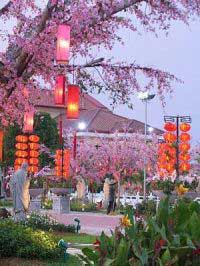Arab perfumes for a change
THERE is nothing like a whiff of perfume to salve the tired soul, so Raghda Emad, 19, of Oud Al Anood (“The House of Good Smells”, in Arabic), believes.
“Arab people like to smell good,” says Raghda.
Raghda, an Iraqi who came to Malaysia when she was just three years old, says her family’s love affair with perfumes started nine years ago when her father, Emad Abdul Razak, 48, a former ship captain, decided to open a perfume factory in Kajang nine years ago. Today, the family-run business has four retail outlets.
 |
A good wood perfume is black. |
“My father is the nose for Oud Al Anood. He spent three years searching for fragrant wood in South-East Asia and experimenting with perfumemaking in our home kitchen.
Even before that, everyone in my family was into perfumes.
“My mother always wore a flowery scent called Amirah, which means “princess” in Arabic, while my father prefers the strong smells of fragrant wood. For me, it’s the soft smells of vanilla,” she says.
The young perfumer’s training in the trade began when she started helping out in her father’s factory at age 14.
 |
Elaborate perfume bottles. |
“I had to open each and every bottle and sniff the contents. Perfume comes in three categories: strong, medium and soft. The strong smells are usually from wood like gaharu, while the mediums are from flowers like rose and jasmine. Vanilla is one example of a soft smell,” she explains.
The shop carries 50 types of scents.
“Everything we use in our perfume oils is natural. There is no alcohol, which means that Muslims can use them during their prayers.”
According to Raghda, they carry two types of perfumes: wood oils and perfume blends of flowers and spices.
“All the wood oils are processed in our factory. The process requires cooking the wood to extract the oil. You can tell a good wood perfume by its colour, which should be black. They are so thick that it is impossible to put them in spray bottles.
“There is no such thing as a good wood oil going bad as they have no expiry date. In fact, the longer you keep it, the better.
 |
Arabian favourites include canned sheep head, brains and feet, and non-alcoholic beer. — Starpix by SAMUEL ONG & GLENN GUAN |
We have a 12ml bottle of 20-year-old wood oil worth RM3,000,” she says.
Raghda says chemically made perfumes have a distinct smell of alcohol and don’t usually last. Some people are allergic to them.
“A good perfume, when applied properly can, last a whole day. Even if you were to dab a little behind your ears, it should carry you through for at least four hours,” she claims.
Oud Al Anood is just next to Hotel Malaysia in Jalan Bukit Bintang. For enquiries, call 012-2154601 (Emad Abdul Razak). Prices start at RM30.
Dine at Aladdin’s
I AM not pulling your leg. I really met Aladdin recently. No, not the character from the
Arabian Nights but a real-life person in Jalan Berangan, off Jalan Bukit Bintang, a spot now dubbed Arab Street.
His name is Aladdin H. Salih (pic), or Ala for short, and he is a 51-year-old Iraqi. Ala is the owner of Sahara Tent, Malaysian Tourism Board’s Best Middle Eastern Restaurant in 2001 and KL Halal Food Guide’s in 2004.
Unlike his fictional namesake, this Aladdin hasn’t a genie for a sidekick, but it has not stopped him from working his magic on his restaurant. Decorated with traditional Bedouin covers, borders and ornate Middle Eastern pieces, Sahara Tent is not unlike the cave in Ali Baba and The Forty Thieves.
“Everything about food I learnt from the women,” laughs Ala.
“During a trip to Malaysia, I realised there was no proper service for the Arab tourist. I saw the potential when no-one did. The location was not considered by many as the right choice as it was considered a ‘red light’ area and the abandoned playground was a haunt for drug addicts. Nevertheless, I went ahead,” he recalls.
Today, Ala’s place is the main draw of Arab Street with its fountains and Moorish arches. The abandoned playground is now nicely lit with fairy lights.
“People say Arab food is like Indian food. In fact, Arab food is nothing like Indian food,” he says.
Middle Eastern cuisine is somewhere between the subtle flavours of Europe and the hot and spicy notes of Asia. In our menu, there is a mixture of all the favourite dishes from the Arab lands,” he says.
Some of the favourites include Babylon Chicken, which is de-boned whole chicken stuffed with basmati rice, pistachios and raisins. It takes two hours to prepare, and is redolent with cinnamon. Another dish Ala recommends is the Whole Roasted Lamb, which is marinated with black lemons, cardamom and cinnamon.
The saffron rice is another specialty, and Ala says it is reserved for special occasions as the spices used can cost up to RM300 for just 100g.
“At Sahara Tent, we blend the saffron to a very fine powder, then add a little sugar and warm water to make a reddish paste. This is then refrigerated, and when the rice is ready, we put a few spoonful of the mixture into it. The result is a beautiful colour and a wonderful smell,” says Ala.
The restaurant also boasts a traditional Yemeni dish called Mandi – chicken or lamb with rice cooked in an earthen pot in a special stove.
The stove, which has a depth of 1.83m, is coated with sand, stone and salt. Firewood is used to heat up the stove for two hours. The basmati rice is put under running water for an hour, then mixed in the pot with meat marinated with cardamom, saffron and raisins. The earthen pot is sealed tight with a wet cloth and left to cook for two hours.
Sahara Tent has Arab-speaking staff at every station and there are curtained booths where veiled women can dine in private.
“It is very inconvenient for Arab females to dine in public as they have to lift their veils. So we allocated these booths where women serve the food. It’s our way of showing respect to the culture,” concludes Ala. W
For reservations, call 03-21448310 or pop by at 87, Jalan Berangan, Off Jalan Bukit Bintang, Kuala Lumpur.
Shisha lifestyle
Jalan Bukit Bintang in Kuala Lumpur should be renamed Shisha Street, judging from the number of
shisha vendors you will find in the area.
According to Mahmoud Jamil Mohammad, 26 (right), a vendor who plies his trade near Waffle Stop beside Lot 10, shisha, or water pipe, is very much a part of Arab culture.
“The Arab world cannot do without the shisha, even the ladies. Anyone who has the time and wants to relax, goes for the shisha and most coffee shops and restaurants in the Middle East have it,” he says.
A shisha session can last 1½ hours, and Mahmoud keeps his regulars happy by regaling them with his tales. He never tires of telling people that he went into the shisha business five years ago because he got of bored staying home and watching TV.
To light a shisha, hot coals are placed on an aluminium foil covering a small earthen receptacle which holds the maasel or dried preserved fruit mixed with honey.
The smoker inhales through the shisha’s long hose, passing the heat and smoke through the long stainless steel body of the shisha. It is a smooth draw, as everything passing through the water in the glass base is filtered and cooled down.
For hygienic purposes, a disposable plastic nozzle is used as a mouthpiece and after each session, the shisha is washed and the glass base refilled.
Customers can choose from nine different flavours like vanilla and cappuccino. He claims that the maasel he uses for his shisha contains no tobacco.
A doctor I talked to says the effects of shisha smoking have yet to be researched thoroughly.
“There is no guarantee that prolonged exposure to it will not affect the lungs. As it is, shisha comes in many varieties and some do contain tobacco. Thus the health risk will also depend on what the smoker is burning.
“In order to ascertain the health risk connected to shisha smoking, we’d have to find out what kind of chemicals are in the shisha. Then we will be able to tell how these substances will affect the smoker. One may say that it is just preserved fruit and honey, but compare that to the haze, which is only smoke from burnt wood.
“In the end, all forms of smoking are harmful, no matter if they are cigarettes or shisha. The safest thing you can inhale is fresh air,” says the physician.
Published in The Star, Saturday 24, June 2006.









 <<>
<<> The night-time scene is breathtaking >>
The night-time scene is breathtaking >> <<>
<<> Abbot Hui Xian >>
Abbot Hui Xian >>
























